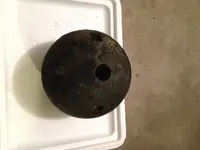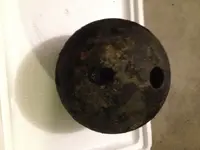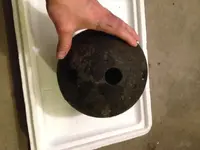sturrat
Full Member
This is a repost in hopes of help with identification.
I went water hunting the other day and stumbled upon an iron ball in about a foot and a half deep water. Carried the heavy thing to shore in my waders and dropped it on the beach. It sure looked like a cannonball at that point. I could not carry it up the hill at that point (its very steep) so I decided to come back another day with a sled to haul it with. To make a long story short it turned out to be a civil war era eight inch mortar. The black powder is gone as you can see in the pictures but it cleaned up well. Any info would be much appreciated! I used my hand and a full sized hammer for size reference. It ways roughly 49 pounds and the walls are approx. 1 3/4 inches thick,
There are two more exactly the same still in the water waiting to be recovered. It looks like an 8" Columbiad smoothbore to me.
Any help will be appreicated
I went water hunting the other day and stumbled upon an iron ball in about a foot and a half deep water. Carried the heavy thing to shore in my waders and dropped it on the beach. It sure looked like a cannonball at that point. I could not carry it up the hill at that point (its very steep) so I decided to come back another day with a sled to haul it with. To make a long story short it turned out to be a civil war era eight inch mortar. The black powder is gone as you can see in the pictures but it cleaned up well. Any info would be much appreciated! I used my hand and a full sized hammer for size reference. It ways roughly 49 pounds and the walls are approx. 1 3/4 inches thick,
There are two more exactly the same still in the water waiting to be recovered. It looks like an 8" Columbiad smoothbore to me.
Any help will be appreicated







